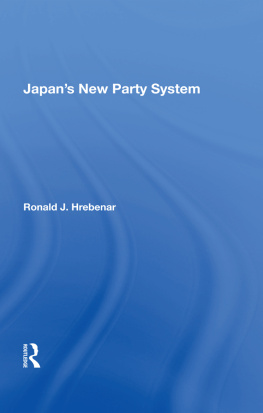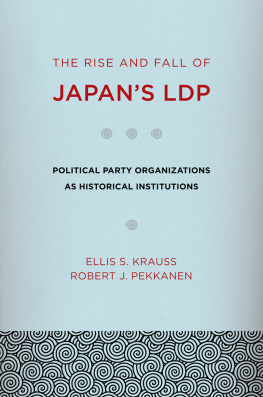Japans New Party System
First published 2000 by Westview Press
Published 2019 by Routledge
52 Vanderbilt Avenue, New York, NY 10017
2 Park Square, Milton Park, Abingdon, Oxon OX14 4RN
Routledge is an imprint of the Taylor & Francis Group, an informa business
Copyright 2000 Taylor & Francis
All rights reserved. No part of this book may be reprinted or reproduced or utilised in any form or by any electronic, mechanical, or other means, now known or hereafter invented, including photocopying and recording, or in any information storage or retrieval system, without permission in writing from the publishers.
Notice:
Product or corporate names may be trademarks or registered trademarks, and are used only for identification and explanation without intent to infringe.
Library of Congress Cataloging-in-Publication Data
Hrebenar, Ronald J., 1945-
Japans new party system / Ronald J. Hrebenar.
p. cm.
Includes bibliographical references and index.
1. Political partiesJapan. 2. Jiy Minshut. I. Hrebenar, Ronald J., 1945-
Japanese party system. II. Title.
JQ1698.A1 H74 2000
324.25201dc21
99051526
ISBN 13: 978-0-367-00970-0 (hbk)
| CGP | Clean Government Party, or Komeito |
| DP | Democratic Party |
| DSP | Democratic Socialist Party |
| HC | House of Councillors, or upper house |
| HR | House of Representatives, or lower house |
| JCP | Japan Communist Party |
| JSP | Japan Socialist Party |
| LDP | Liberal Democratic Party |
| LP | Liberal Party |
| NFP | New Frontier Party, or Shinshinto |
| NLC | New Liberal Club |
| SDPJ | Social Democratic Party of Japan |
The authors of this book have joined together for a third time to produce a book on Japanese political parties and elections. The first two books under the title of The Japanese Party System were also published by Westview Press in 1986 and 1992. This book, Japans New Party System , has a different purpose than the previous volumes. The first two books had as their task the presentation of a vast amount of material on the various parties of the 19551993 party system. Since 1955, Japanese politics and parties had been rather uneventful and predictable; consequently, many Japanese political scientists preferred to study other nations. Decade after decade, the Liberal Democratic Party (LDP) ruled Japan while the permanent opposition party, the Japan Socialist Party (JSP) revolved around it but could never even come close to replacing it in power on the national level. All of this changed in 1993 after the LDP split, new parties emerged and formed a non-LDP government, and a new party system began. This book is about the Second Party System and how Japanese politics has changed from the old LDP-dominated First Party System.
This book begins with an introduction to Japanese party history and electoral behavior. The next two chapters address changes in Japanese election law and political finance..
Expert analysis is provided by two of the worlds most knowledgeable professors on Japanese political parties. J.A.A. Stockwin of Oxford University and the recently retired Peter Berton of the University of Southern California offer their considerable insight on the Socialist and Communist parties of Japan. Professor Akira Nakamura of Meiji University in Tokyo contributes his enormous knowledge of Japanese politics to the chapter on the LDP. I thank these three political scientists for their significant contributions. Without them, this book would not have come into existence.
As the lead author, I want to express my appreciation to all the academics and journalists who helped with the data collection and reading of these chapters. I acknowledge that any errors remaining are entirely my responsibility, despite the efforts of these experts to teach me about Japanese politics and parties. I sincerely thank them for their efforts on my behalf.
I also want to thank those who helped produce this book. Especially important are Carol Jones and Steve Haenel at Westview Press and Lesley Rock at PageMasters & Company who labored to turn confusion into communication. Amy Rogers of the University of Utahs Department of Political Science also made important contributions in and in the conversion of the text into a readable form on the computer.
Japanese politics in the late 1990s has stopped being boring and has become fun. We hope the reader will find this book to be a helpful guide to understanding Japans new party system and politics.
Ronald J. Hrebenar
As is common practice in Japan, all Japanese names are written with the family name first and the given name last. If the Japanese scholar is living in the United States or publishes in English, I have presented his or her name in the American stylefor example, Haruhiro Fukui or Akira Nakamura.
one
The Changing Postwar Party System
Ronald J. Hrebenar
The Japanese political system is democratic, has several parties, legislates through a parliament (the Diet), and has a well-educated, supportive, but basically uninvolved, electorate. It has also been defined by the continuous rule for three decades of the conservative Liberal Democratic Party (LDP), which held a majority of seats in the Diet between its formation in 1955 until it lost its majority in the House of Councillors (HC) in 1989 and then its control of the House of Representatives (HR) in 1993. In this introductory chapter these basic characteristics of the Japanese party system will be explored to provide the reader with a foundation for the subsequent detailed examination of the major parties in the current party system. The chapter is based on a variety of types of data, especially public opinion polls of the Japanese electorate.
Prime Minister Hashimoto Ryotaro announced his resignation on Monday, July 13the day after the LDP defeat in the 1998 HC elections. Immediately, the Japanese media began the frequently played game of speculating on who would be the next Japanese prime minister. The names put forward were truly the usual suspects, including former LDP president Kono Yohei, who had stepped aside three years earlier to give Hashimoto his clear shot at the prime ministership; former LDP president and prime minister Miyazawa Kiichi, who was prime minister when the LDP split in 1993, allowing the opposition to form the first non-LDP government since 1955; Obuchi Keizo, the foreign minister and leader of the most powerful faction within the LDP and boss of Hashimotos faction; Kajiyama Seiroku, the most crafty deal maker left in the LDP; and Koizumi Junichiro, one of the most unconventional LDP Diet members. Obuchi was the winner of the
These events can tell us much about the nature of party politics in contemporary Japan. The central theme of this book is that Japan has moved into a new style of party politics since the breakup of the LDP in 1993. This new era of politics is called the Second Postwar Party System (SPWPS). The First Postwar Party System (FPWPS) began with the creation of the LDP and the JSP in 1955 and died in the disarray of 1993. One of the interesting aspects of this change in party systems is that some things never seem to change in Japanese politics. First, despite the emergence of new parties and the destruction of old parties, the LDP still rules Japanese national politics. When the LDP lost seats in the 1998 HC elections, it did not have to relinquish control of the government or even resign the prime ministership. Hashimoto resigned because he had so inflated expectations prior to the voting that the winning of 44 of the 126 seats contested (the most seats won by any party) was considered a defeat, since he and other LDP leaders were talking about winning more than 69 seats and, surely, at least 61, the number they were defending in the election. The LDP still had a 13-seat majority in the crucial HR. The second feature is that the LDP continues to recycle one weak prime minister after another as though they were all faceless cogs in a perpetual machine. The question regarding the possible successors to Hashimoto were all focused on whether any of these LDP leaders could actually lead the nation in its troubled times. Japans economy had been stagnant since 1990, and the various LDP and opposition leaders had no idea how to break the nation free from the pattern. Third, the LDP leaders, and thus the prime ministers, still emerge from the murky depths of the partys internal factional maneuvering despite the official disbanding of the factions in the early 1990s. The fact that Obuchi was seriously considered a potential prime minister had nothing to do with his new ideas, leadership skills, or great public respect and support because, clearly, these did not exist. He was the heir of past prime ministers such as Tanaka and Takeshita who had led his faction in previous decades, and thus he automatically was a contender for the post of prime minister. Kono was one of the few sincere reformers in the party, and Miyazawa was one of the few LDP members who understood economics. Each represented different LDP factions in competition for party and governmental power. Strangely, another candidate emerged, the hard to categorize Koizumi Junichiro, who represented the Mitsuzuka faction and appeared to appeal to younger LDP Diet members who were concerned with their electoral prospects if the party chose a leader such as Obuchi.













